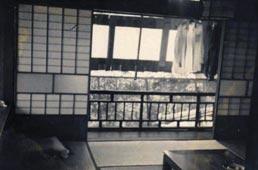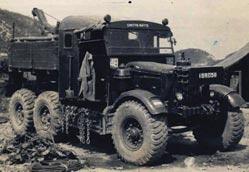
8 minute read
Korea: Landfall Dinners, Draining Jeeps and Winter Kit
Korea
Landfall Dinners, Draining Jeeps and Winter Kit
Advertisement
Today, the Korean War is often overshadowed by its more famous relative, the Vietnam War. However, for many REME Soldiers and Officers, Korea was a significant point in their service. In the first of a two-part series, Lt Col (Retd) Denis Redmond shares his experience of being posted to Korea, from sailing there through to surviving winter.
It began with a posting order to Southampton to board Troopship Empire Orwell the day before official boarding to assume duty as Troop Deck Officer. With no idea what that meant, I was met by a permanent staffer who took me below to view my new command accommodation; rows of double bunks in a claustrophobic steel lined space below the waterline. There were several Troop Deck Officers covering the entire troop accommodation.
As I remember, my primary job was to inspect feet, which seemed incongruous to me; we were not marching to Korea. However, looking after a mixed batch of Regiments did not turn out to be too onerous a task. There was nowhere they could stray. I classed it as light duties and was delighted that on the first night the ship’s Officers threw a party to welcome us on board. It was there I met an RAMC Major and two QARANC Nursing Sisters stationed on the ship fulltime. We remained friends throughout the whole trip.
Next day I saw my bunch safely into their space, read out travel Standing Orders and left them in the hands of their NCOs. My accommodation, a four-bunk cabin, was partially filled this day with an Army Air Corps Pilot, probably still Glider Pilot Regiment in those days, a Light Infantry Captain and an empty bunk. We got on well.
The ship left port the day after with little fuss. I forget which shipping line manned the Orwell, but they were a grand lot. I remember the Chief Engineer. He looked for REME Officers to show them his beloved engines and so it was I spent a whole morning nodding and shouting my admiration down in the bowels among the familiar smell of hot oil and noise of running machinery. It was then I discovered the Orwell had been a Nazi Strength-Through-Joy ship taken as part of German reparations after World War 2 and fitted with new boilers. “Come down any time”, he’d said, but once down there was enough.
After a few days we all settled into the ship’s routine. Mostly it was boring and I was glad of the daily visit to my Troop Deck.
I could go on about the ship and the trip but that would take a whole book on its own. Enough to mention the highlights, one of
The Japanese hotel HMT Empire Orwell
which was landfall dinners. There were, of course, Officers’ wives on board, sailing to join their husbands in Aden, Singapore and Hong Kong. They made a pleasant change to the mostly male environment. But I digress. Landfall dinners. A device of the Ship’s Officers. Whenever land was sighted it called for a special dinner, a sort of Dinner Night. I swear they had a man on the bridge with a very powerful telescope whose singular job was to search for land. He came up with it with surprising regularity. Then we broke down off Aden, it was the air-conditioning. Parts had to be flown out from the UK and that held us up for three days; it was hot.
From Aden, we progressed to plan, calling at Singapore and Hong Kong on-route, finally docking in Kure in Japan. I was collected from the docks and jeeped to Base Workshop Japan, an Australian unit, where I remained for a few days awaiting transport to Korea and the First Commonwealth Division.
After about 30 days on a ship with little escape, land seemed almost alien. That, plus a strange new culture and two new nationalities, Japanese and Australian, might have been tricky to assimilate, but luckily another British REME Officer had been waiting at base for transport. He was starting a second tour for which he had volunteered and he knew his way around.
Stuck there over a weekend, Drummond, for that was his name, took us to a traditional Japanese hotel in the hills overlooking Kure. Patterned paper sliding partitions, low, coffee-like tables along with Geishas in traditional dress and makeup made for a surprisingly delightful ambience that I soaked up. Nobuko San, one of the two Geisha, played the samisen, a sort of Japanese guitar and sang strangely discordant songs that seemed completetely right for their surroundings. I was sorry it had to end but end it did.
Back at base, movement orders for Drummond and I were waiting: “Take the night ferry to Pusan and then by rail to the railhead.” The train journey was under American control and gave me my first experience of self-heating soup. Pull a tab at the bottom of the can and the soup, or whatever else, heats up. A wonderful innovation, I thought, for use in the field; no need for fires or smoke to give your position away. Maybe we had something of the same but I’d never seen it.
At the railhead I was picked up by a jeep bearing REME colours driven by a Craftsman, whose name I have long forgotten, and taken


The LAD
Chotta Matte
there I found myself, attached to 12 Squadron for administrative purposes and with a brand new LAD to work in. 12 Squadron’s Officers’ accommodation consisted of caves excavated out of the hillside, hanging canvas entrance doors, two trestles supporting a stretcher for a bed, all heated by a petrol-fuelled stove. Mine was at one end of a row. I drove a couple of wooden pegs into the soil above my bed and made a shelf for my books. I had been issued with winter kit; inner and outer sleeping bags, masks to cover your face at nights to prevent getting frozen to the sleeping bag and several layers of clothing culminating in a thick Parka with a hanging section for your bum when you sat down. Oh! And boots cold and wet. We nicknamed the boots ‘cobbly wobbly’. Korean winters are very cold. We were not a large LAD. I inherited a jeep with a type 19 radio set in the back, a machinery trailer equipped with lathe, drilling machine and grinder, a Scammell named Chotta Matte, which I was told means ‘wait a minute’ in Korean, a three-ton recovery truck and various other 3 tonners including a 3-ton ammunition truck. We were armed, on a war footing and on war-time accounting. The LAD photo is old and scarred, and my AQMS is not there; he probably took the photo and one or two Craftsmen would have been on R and R in Japan. Otherwise that is a fair representation. Winter was hell. You could be in shirt sleeves at lunch and freezing by four. You dare not go anywhere without your winter kit. Engine oil became so thick engines wouldn’t start. I ran a shift system to run Chotta Matte through the night so in the morning it was available to tow start regimental vehicles. One delight was that on a frosty morning you could step outside before the sun burned off the frost and the air sparkled with brilliant particles. A major nuisance was the large static charge that accumulated on all vehicles in the winter, making refuelling a dangerous business. Vehicles were fitted with earthing chains to drag on the ground or had a spike added to the chain to earth the vehicle during refuelling. You could get a wallop off cab doors if you were not careful. We even heated hand tools to prevent frost burns. The River Imjin froze solid in winter, which led me to manufacture three Ice Yachts with sails provided by 12 Squadron (from where - goodness knows). We had a lot of fun with them. Engineers built me an office with space for me and my Clerk and it to 12 Infantry Workshop, if I remember correctly. The Workshop was was heated by one of the notorious petrol stoves. These stoves were sited, mostly under canvas, on the west bank of a small river. I was renowned for brewing over, which wasn’t so bad if you were there to introduced to the Officer Commanding, who informed me he didn’t deal with it. However, to my embarrassment, one lunch time, my have a job for me; there were simply too many REME Officers in the office stove went wonky and set it on fire. The lads tried to extinguish Division. I could help his 2IC. it but when I got back from lunch my office was a smouldering ruin.
A prevalent fault out there occurred with the auxiliary gearbox of It was no one’s fault, but I hated it was the LAD. The Engineers had a the Willys Jeep. The standard repair required draining all liquids from laugh and gave me a surplus office truck as replacement. The photo the vehicle and the use of many hands to tip it on its side. Access to is of me on the steps of my new acquisition chatting with the the gearbox was thus easily obtained. I was amazed to find so many Regimental Medical Officer. jeeps in this configuration along the bank of the river. It was an interesting few weeks, discovering similar shortcuts in equipment repair developed over years of warfare. It was not to last.
My first engineering command came almost by accident. The Engineer Regiment LAD had been found by New Zealand REME. However, with the Panmunjom armistice a certainty, New Zealand began running down its Commonwealth contribution, which included 28 Engineer Regiment LAD. CREME (Lt Col) Good, as I recall, was quick to cobble together a British replacement LAD. Who did he have spare to take command? Yours truly.
Commonwealth Divisional Engineers, 28 Engineer Regiment, comprised two British Squadrons and one Canadian. Most units had pulled back from the Kansas Line. Kansas was a well prepared contiguous line of defensive positions that ran from coast to coast and, apart from regular maintenance crews, was unmanned. Thus the Engineers deployed a Canadian Squadron north of the Imjin River and two British Squadrons, to the south on the eastern side of MSR Route 11, sandwiched between two rows of fair-sized hills. (Korea is a very hilly country.) It was Winter in Korea The office truck











